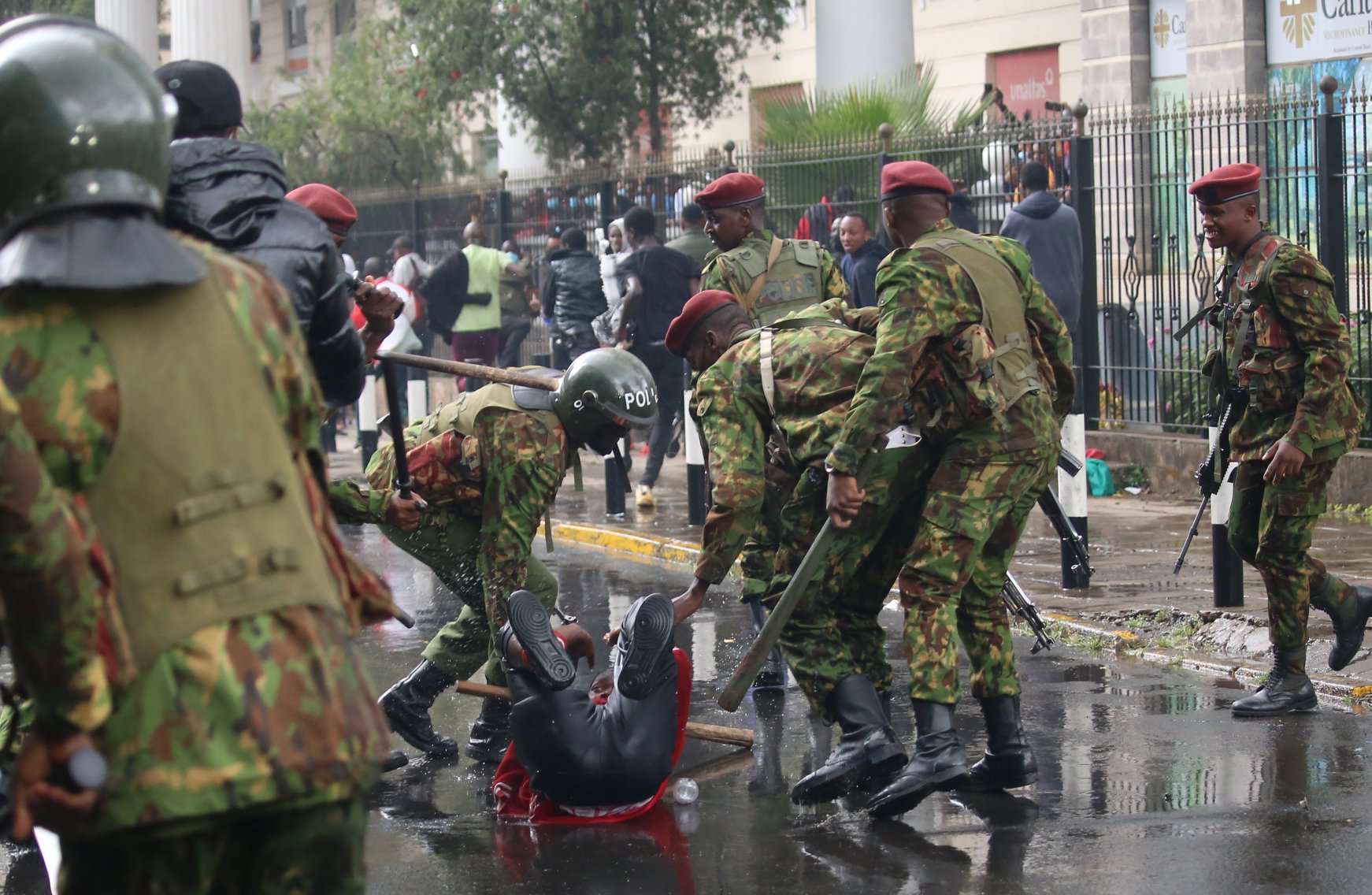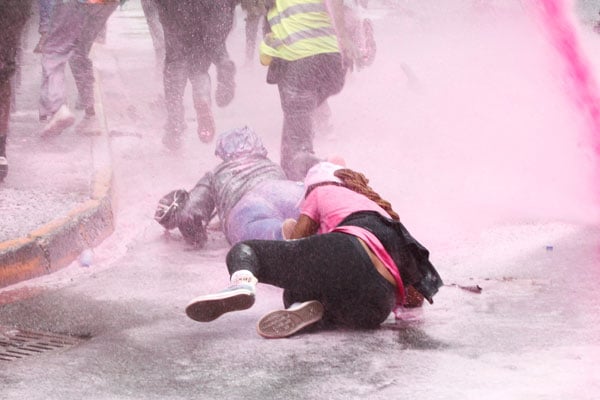
Protesters engage police in running battles during anti-Finance Bill demonstrations in, Nairobi, Kenya, this week. PHOTO/ FILE
The revolution will (not) be televised. It may also not be exported; old sayings have claimed. This week, these two notions were disabused.
An energetic group of protesters poured into the streets of Nairobi, Kenya, and later other cities, to picket against proposed controversial tax increments. They also recorded and shared their protests on Tiktok, X and other social media platforms.
Then other Africans started talking. Even Kenya’s Opposition leader Raila Odinga, who has lately enjoyed government back-up for his African Union Commission chairperson contest, took note.
He said he was “a proud father” after youngsters pulled off a surprising protest without old political hands.
Whether the protests succeed at all would be seen in the kind of Finance Act passed by Parliament, or the kind of taxes Kenyans pay from next week.
It was dubbed a ‘Gen Z revolution’, because participants were mainly young Kenyans, possibly first-time voters. Some experts though warned it would be too early to call it a revolution.
“It is just two days into the protests, and I am not sure the numbers in the streets really match up. The ratio of people in the streets to the general population is a determining factor. Revolution is bigger than that but time will tell,” Dr Hawa Noor, an independent researcher and affiliated Fellow at the Institute for Intercultural and International Studies [InIIS], University of Bremen, told The EastAfrican.
“The developments at the moment are quite good, but I should say this is not the first time people have gone to the streets to demand accountability from their leaders. They did so in the 1990s: people like James Orengo (now Siaya Governor) did so, we had IPK (Islamic Party of Kenya) demonstrations in Mombasa and people were killed. So there is nothing new, perhaps the dynamics are different,” she added referring to the quest for multiparty politics back in the 1990s.
Most of those protesting this week weren’t born yet. Although the demographics of the entire participating group has not been determined yet, older bearded folks were also in the demos.
However, pouring in the streets was more of people feeling hurt by tax policies, rather than choosing to upend the system that governs.
Dr Noor says people tend to rally if the policy shift affects them such as when boda bodas protest crackdowns or cost of living rises.
“The finance bill touches on everybody so they feel it. But we have seen people look the other way when minorities are targeted. It is important to realise that there is a problem with our system from a historical perspective that needs to change, instead of this selective reaction,” she argues.
One successful thing so far has been the ability of protesters to cross the line of online activism to real street protests.
Some commentators had argued that virtual protests alone have this kind of unreal tendency to create a “feel-good” sense of satisfaction at low cost.
“When compared to an offline protest, social media activism competes with child play,” argued Eric Gatobu, a commentator on social media trends, in a recent commentary.
“Depending on the individual’s socio-economic status, the resources required are enormous. Think of time alone, the working class have to create time out of their unforgiving schedules to picket in front of parliament, there is a real risk of violence from the police which over the years has proven to often result into death as well as the unwelcome possibility of jail time and subsequent loss of livelihood,” he argued in a blog post.
The protesters, this time, feared no teargas, nor arrest. They even sang in the jail cells.
Kenyans aren’t the first though to defy police. In 2019, courageous youngsters poured into the streets of Khartoum, Sudan, to protest against rising prices of bread.
One of the prominent leaders of the protests was Alaa Salah, then 22-year-old protester who said she wanted a better country to live in and that forced her in the streets to demand it. She and others wanted then Sudanese leader Omar al-Bashir to step down.
After months of brutal responses from the security forces, the military later crossed the floor to the side of the protesters ostensibly to provide stability. But it was actually to hijack it.
“In Sudan, arms became an issue. And when generals took over the revolution under the guise of providing stability and restore order, they then started to quarrel among themselves,” said Macharia Munene, professor of History and International Relations at the United States International University (USIU)-Africa.
“We hope Kenya doesn’t reach a situation where the military has to step in,” he told The EastAfrican.
Nonetheless, Sudan’s youth-led protests that lasted 111 days suffered the indignity of its beneficiaries being those who had spent months beating it down. Those who had poured in the streets have now become internally displaced, refugees or forced into war, four years down the line.
Dr Jihad Mashamoun, political analyst on Sudan, and honorary research fellow at the Institute of Arabic and Islamic Studies at the University of Exeter (UK) says the protesters were played by both the military and the civilian movements that wanted al-Bashir out.
“Both the military and the parties of the forces of freedom and change hijacked the revolution,” he told The EastAfrican.
“They were worried that the youth’s revolution would displace them completely. Hence that is why they accepted power sharing agreement.”
The youth may still be relevant but their roles have changed to working as first responders in the emergency, or compelled to take sides in the war: Sudan Armed Forces (SAF) and the Rapid Support Forces after Sudan plunged into war last year.
Like Kenya’s, the youth in Sudan had kept their protests peaceful in spite of the police brutality. And after Bashir was ousted, a transitional military council was formed with Abdel Fattah al-Burhan, as chairman and Mohamed Hamdan Hemedti, leader of RSF, as deputy.
A few months later, they shared power with civilian movements and installed Abdalla Hamdok as Prime Minister. He would be deposed in October 2021 by the military council. The council itself fell apart last year after Hemedti’s forces launched a war on SAF.
Yet Dr Mashamoun thinks the youth can still regroup and beat back the junta, and win back their victory.
“Far from it (stalling), it (revolution) has been delayed as a result of the war, but not over,” he said.
“In fact, state leaders, civilian leaders, and the RSF fear the change because each had resulted in the delay in Sudan’s democracy. At the moment, what I’m sensing from the youth is to end this war so they can focus on further the revolution through accountability.”
In countries across Africa, agitated youth have often been rounded up and detained, or social media shut down to prevent coordination. But that hasn’t stopped politicians from looking into this constituency and turn it into allies.
In Uganda, for instance, President Museveni, in power since 1986, started calling them Bazukulu (grandchildren), often regaling his audiences with long tales about the Bush War and African philosophy.
Whether they enjoy that is debatable. But one of his main rivals, Robert Kyagulanyi, aka Bobi Wine, was just four years old when Museveni took over.
Prof Munene thinks politicians will always jump in these kinds of ‘revolutions’, whether to profit from them or just take the wind out of the sails.
“It is highly possible of getting hijacked by the political class. They would like to jump in and appear to be the ones leading it. But if it fails, they will then jump off,” he spoke of the Kenyan protests, but indicated it was also a general pattern continentally.
“There is currently no unifying factor so far, other than social media connections. If someone comes up to lead it, there is likely to be competing interests to split it.”
Dr Noor says history shows politicians often hijack useful popular public moves.
“Some politicians are already framing it, interestingly, by arguing that people like Dedan Kimathi (freedom fighter) paid it with their lives and that taxes are a lesser price to pay and hence minimise the danger in the Finance Bill. It has already been hijacked with narratives,” she told The EastAfrican.
Overall, however, it initially unsettles the political leadership. And for Kenya’s, the protesters are shaking up a middle class initially thought to be indifferent to political activism.
“Kenya’s seems to be a middle class affair. They seem educated, not desperados we are used to see in the streets. But they are desperate to rescue their middle class which is under depression and they are reacting that,” Prof Munene said.
Kenya’s president William Ruto is under a lot of pressure now because they are reacting to the political depletion of their middle class.





